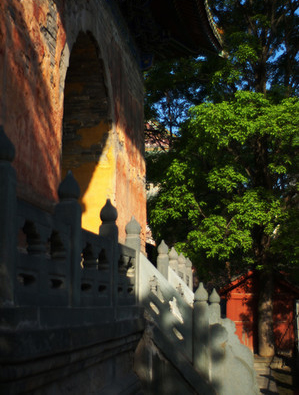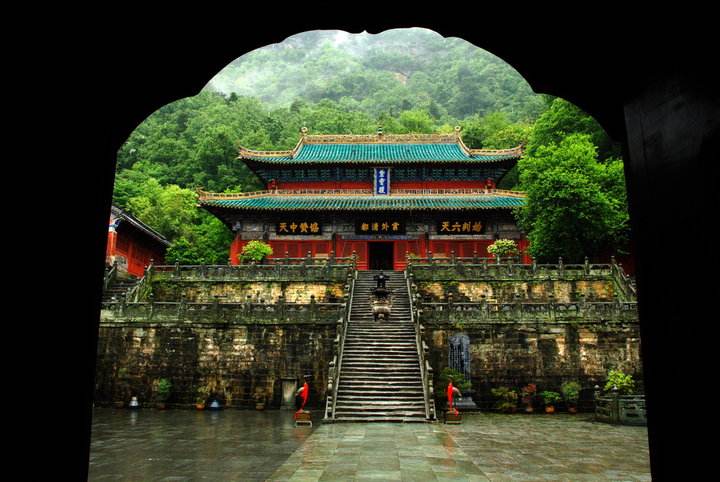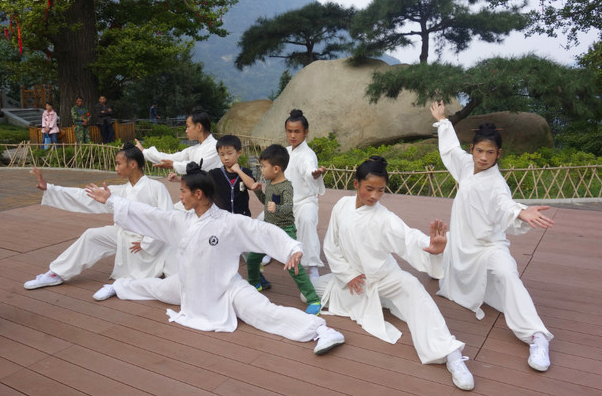
In the northwestern region of Hubei province, the mysterious Wudang Mountains rise up in a sea of clouds. Resplendent with dense forests, trickling streams, and vast caves, it is a mountain range of unparalleled natural beauty. Yet it is more well-known for the Taoist temples and monasteries scattered throughout its expanse, which are considered so exemplary that they were collectively designated a UNESCO World Heritage Site in 1994. While the Shaolin Temple in Henan province is heralded as the source of Chan (Zen) Buddhism and Shaolin Kung-Fu, many regard the Wudang Mountains as the legendary birthplace of Taoism and the practice of Tai Chi. In fact, the three “internal” martial arts, known as Tai Chi, Bagua, and Xingyi, are classed as Wudang styles.
Building began on the mountains as early as the Tang Dynasty (618-907), when Emperor Taizong commissioned the construction of the Five Dragons Temple, and further religious structures were added during the Song (960-1279) and Yuan (1271-1368) dynasties. However, it wasn’t until the Ming Dynasty (1368-1644) that the mountain range was finally recognised as prime piece of spiritual real estate! The Yongle Emperor claimed to enjoy special protection from the Taoist deity Zhenwu or the “Dark Warrior” and, since Zhenwu supposedly attained immortality while living on the Wudang Mountains, the Emperor felt this would be the ideal location to build a temple complex dedicated to him.
While some people have shopping sprees, it seems the Ming emperors were wealthy enough to have building sprees! At its peak during the Ming Dynasty, there were a staggering 9 palaces, 9 monasteries, 36 nunneries, and 72 temples located on the Wudang Mountains, most of which were built under the instruction of the Yongle Emperor. Unfortunately, due to their precarious location, maintaining the temples was extremely difficult and they frequently had to be repaired or rebuilt. Nowadays, only 53 of these ancient buildings and 9 architectural sites remain.

Situated on the southern side of Tianzhu Peak, the Golden Hall is part of a much larger complex known as the Palace of Harmony, which also contains the Forbidden City and Gutong Hall. Standing at 6 metres (20 ft.) in height and 3 metres (10 ft.) in width, the Golden Hall is so-named because it is entirely made of bronze. Within the hall, you’ll find a bronze statue of Zhenwu, which reputedly weighs over ten tonnes. To put that into perspective, that’s nearly twice the weight of an African elephant!
The nearby Purple Cloud Temple, which is perched on Zhangqi Peak, was built in 1413 and is another highlight of the mountain range. Covering a colossal area of 6,850 square metres (73,733 sq. ft.), it consists of the Dragon and Tiger Hall, the Stele Pavilion, Shifang Hall, the Grand Hall, and numerous other structures. With its blue glazed-tile roof and intricate wood-carvings, the Grand Hall is particularly magnificent and is considered emblematic of wooden structures from the Ming Dynasty.
Nanyan or “South Cliff” Palace, which is named simply because it faces south, was built during the Yuan Dynasty and is said to be the most sacred place on the mountain range, since it was rumoured to be where Zhenwu attained immortality. Tianyi Zhenqing Hall within the palace is considered particularly spectacular, since all of its beams, pillars, doors, and windows were carved from stone. So don’t be offended if you get a stony reception during your visit!
Although many of the oldest buildings have now been lost, the temples and palaces of the Wudang Mountains represent over 1,000 years of artistic and architectural progress, and are considered some of the finest examples of Yuan, Ming, and Qing (1644-1912) Dynasty style architecture in the country. They provide an insight not only into the historical periods during which they were built, but also into the progress of Taoism as an indigenous religion in the country. While the range’s historical connection to the imperials is palpable, its designation as the birthplace of Tai Chi is the subject of heated debate.

According to legend, a Taoist hermit named Zhang Sanfeng came to live in a monastery on the mountains and supposedly invented the concept of neijia, which encompasses the art of Tai Chi. In Chinese martial arts, the term neijia refers to styles that train and harness the power of the three internal treasures: “Jing”, the essence and inner energy of the physical body; “Qi”, the natural energy that flows through all things; and “Shen”, the original spirit of the body. While Shaolin Kung-Fu focuses on improving the strength and power of the body through physical exercise, neijia-style martial arts employ meditative exercises to enhance the body’s three internal treasures.
Since Zhang Sanfeng was purported to have lived for over 200 years, it is unsurprising that historians doubt the accuracy of the records surrounding him. However, even if the stories aren’t strictly true, the spiritual nature of the Wudang Mountains and the temples that populate them is undeniable. Whether it be strolling through the forests on a dusty afternoon, wandering the temple halls in the pale light of morning, or simply sampling a cup of locally grown tea in a mountain teahouse, a visit to the Wudang Mountains is guaranteed to be time well spent.